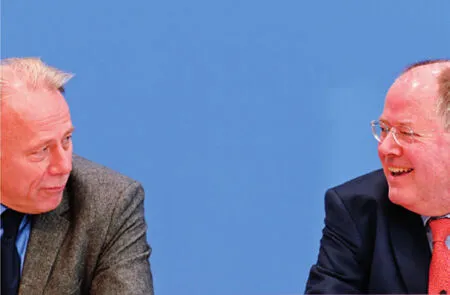Germany in Transition
2013-12-06ByYangChengxu
By Yang Chengxu
political parties vie for votes ahead of major election

The author is a senior research fellow with the China Institute of International Studies
Deep and complicated changes have been ongoing in Germany’s political architecture in recent years. The biggest German political party, the Christian Democratic Union/Christian Social Union (CDU/CSU), maintains a wide influence under current Chancellor Angela Merkel’s leadership, boasting an approval rating of over 40 percent. Compared with leaders of other parties, Merkel has the highest approval rating at over 50 percent.
At a time when the United States is struggling with the financial crisis and many European countries are in trouble due to sovereignty debt crises, Germany has never shifted its focus from the economy. It has managed to sustain stable economic development, becoming an outstanding performer among European economies. Germany values the healthy development of the euro zone, and considers it a solution to sovereignty debt crises. It offers financial support to crisis-ridden European countries on condition that they adopt tight fiscal policies. Germany’s international status is on the rise, as some EU countries refer to it as the leader and super power of the EU.
In the local parliamentary election of Lower Saxony in January, however, the Social Democratic Party of Germany (SPD) and the Greens beat the CDU and its ally, the Free Democratic Party (FDP), albeit in a weak victory of just one seat. The CDU took 36 percent of the votes in the state election, the SPD 32.6 percent, FDP 9.9 percent, and the Greens 13.7 percent. The Left Party and the Pirate Party both failed to win 5 percent of the votes, which means they will not be included in the next state parliament. The election results foreshadow a furious fight between the two major parties of Germany, CDU/CSU and SPD, in the coming federal election in September.
party shakeup
German media assign names to each party:black for CDU/CSU, red for SDP, green for the Greens, yellow for FDP, and red for the Left.Whether in the general election or local elections, parties sharing similar stances can form administrative coalitions through negotiations carried out before or after elections. For most of the time after World War II, CDU/CSU and SDP have formed alliances respectively with FDP and the Greens. Occasionally, the two major parties formed a large coalition government.
Theoretically, if a major party and its ally fail to get over half the votes in an election, the major party can form an administrative coalition with two other small parties. For example, there can be a coalition of SPD, FDP and the Greens with a red-yellow-green (“traffic lights”) pattern.There also may be a coalition of CDU, FDP and the Greens with a black-yellow-green pattern(dubbed “Jamaica” because its colors match that country’s national flag). However, these two patterns have never occurred because of the mutual repulsion between FDP and the Greens.A major party plus a small party is the only coalition pattern that has worked in Germany.

POPULAR LEADER:German Chancellor Angela Merkel speaks at the opening ceremony of the CeBIT technology fair in Hanover on March 4, 2013
SPD and CDU/CSU possess a massive following of voters. But SPD’s situation has been declining in recent years. Being on the left of the political spectrum, SPD members were mostly workers in the past. But lately SPD’s member base is changing, as more white-collar employees join. SPD won the federal election in 1998 and formed a coalition with the Greens,with Gerhard Schroeder taking the position of chancellor.
At that time, SPD was aware that Europe’s economy would soon face a crisis from an aging population and a rising debt threat. The party found that social welfare expenses had grown too quickly beyond the endurance of society. It proposed adopting an austere fiscal budget and cutting employee welfare, which led to party disputes. Former SPD Chairman Oskar Lafontaine accused the party of moving to the right. He resigned and established a new party called the Labor and Social Justice Party, a move that weakened SPD. Some SPD supporters turned to the Greens, and in the meantime SPD has shown no strong leaders. Due to the internal disputes, SPD didn’t find a candidate for the next German chancellor for a long time. Last December, it finally chose Peer Steinbrueck as its candidate. But his approval rating has been around 30 percent, which is far below Merkel’s.

MERKEL’S CHALLENGERS: SPD’s chancellor candidate Peer Steinbrück (right)and the Greens’ top candidate Jürgen Trittin jointly attend a press conference in Berlin on December 12, 2012
The Greens oppose nuclear power,condemn war and advocate environmental protection, while calling for building a just society. Its influence is growing with time. The political stances of the Greens and SPD are similar. Young people not pleased with SPD’s right leanings typically turn to the Greens. The Greens propose shutting down a nuclear power station every year until 2021, at which point all nuclear power plants in Germany would be closed. The party won the federal election in 1998 together with SPD, becoming the national ruling party for the first time in its history. There are 17 nuclear power plants in Germany.German voters overwhelmingly support the Greens’stance on closing nuclear power plants, especially since a nuclear leak occurred in Japan after the earthquake on March 11, 2011. In recent years, the party’s approval rating has been around 15-16 percent in local parliamentary elections. It has now become the third largest party in the country and the only party that is qualified to form a coalition with either CDU/CSU or SPD.
FDP had been a major party in Germany for a long time after World War II. It used to occupy a flexible position between CDU/CSU and SPD.But since the emergence of the Greens, FDP not only has lost its flexible status, but also seen its approval rating decline to around 3 percent.
The Left was founded in 2007 by merging the Party of Democratic Socialism, an influential party in former East Germany regions,and the Labor and Social Justice Party. Most parties reject the Left and oppose forming a coalition with it. Only in Brandenburg have the Left and SPD formed an administrative coalition, because the two parties have occupied an unbeatable 60.2 percent of the votes. If the two major parties cannot form a coalition with any other small party to win the majority of the parliament, the Left will play a role in the formation of a future government.
Except for the above-mentioned five parties, the Pirate Party, which was established in 2006, is also an influential party. The party vows to support the preservation of civil rights on the Internet. By now, it has seen approval ratings over 5 percent in Berlin, Saarland,Schleswig-Holstein and North Rhine-Westphalia parliamentary elections and entered local parliaments. However, its influence has recently been on the decline. If it can enter the federal parliament, it may exert a delicate influence over the coalition pattern between big and small parties.
Election predictions
On February 13, Germany released two reports on the approval ratings of different parties. The report of the Die Zeit weekly newspaper and the Forsa Institute said that CDU has stepped out of the setback in Lower Saxony. Now CDU/CSU’s approval rating has reached 43 percent,the highest in seven years. FDP and the Pirate Party failed to get an approval rating above 5 percent. In the meantime, SPD got 25 percent,the Greens 14 percent, and the Left, 7 percent.The statistics show that CDU/CSU has earned a great advantage.
Meanwhile, a report by Das Erste, a principal public Tv channel in Germany, released a list of approval ratings: CDU/CSU, 40 percent; SPD,27 percent; FDP, 4 percent; the Left, 7 percent;the Greens, 16 percent; and the Pirate Party, 3 percent. According to this report, SPD still has some influence in Germany. This year’s general election will be a fierce fight.
There are several potential outcomes from the coming general election:
First, two possible combinations will be CDU/CSU plus FDP and SPD plus the Greens.These combinations will be formed on the basis of their similar political stances and their experience with coalitions.
Second, if the combination of a big party plus a small party cannot gather 50 percent of the votes in the federal election, there is a big possibility that the two major parties will organize a coalition government, which has happened before. However, as many disputes exist between them, such a coalition can hardly last long.
Third, according to current poll results, FDP’s approval rating is under 5 percent, which makes it difficult for the party to enter the parliament.And then it will be hard for CDU/CSU to form a coalition with FDP. For the SPD, if its approval rating cannot pass 30 percent, it can scarcely win victory with the Greens in the general election. A coalition of one big party plus two small parties is possible, such as black-yellow-green,red-yellow-green or red-red-green. The Left has a slim opportunity to enter the cabinet, but it has a great opportunity to play an influential role in negotiations with related parties in forming a cabinet. Besides, it is still difficult to say whether the Pirate Party can win 5 percent of the votes and enter the parliament.
More than four months remain before the general election. The international situation and the domestic political mood in Germany may change in that time. But the ultimate results of the general election will be included in the three predictions. ■
